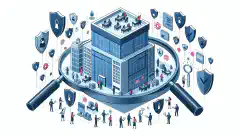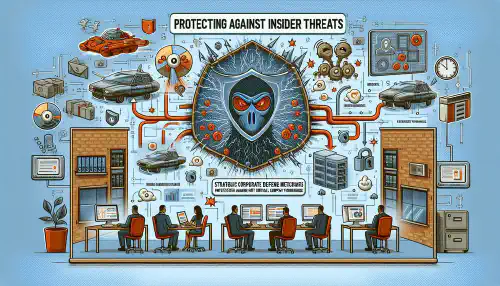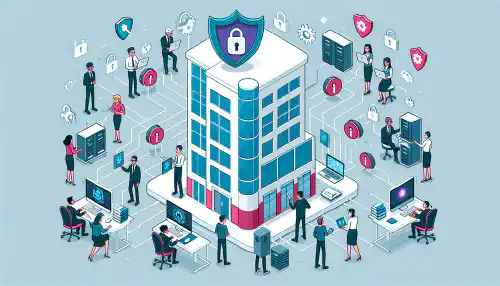Shield Your Company: Insider Threat Protection Strategies Unveiled

Table of Contents
Protecting Against Insider Threats: Strategies for Your Company
Insider threats pose a significant risk to the security of companies, as they involve individuals who have authorized access to sensitive information and systems. These threats can come from employees, contractors, or partners who misuse their access privileges for personal gain or to cause harm. In order to protect against insider threats, organizations need to implement a range of strategies that focus on prevention, detection, response, and creating a culture of security. This article explores key strategies for protecting against insider threats and provides actionable takeaways for companies to enhance their security measures.
Key Takeaways
- Implement strong access controls to limit the potential for insider threats.
- Regularly monitor and audit user activities to detect any suspicious behavior.
- Educate employees on security best practices to minimize the risk of insider threats.
- Utilize behavior analytics and user activity monitoring tools to identify potential insider threats.
- Establish incident response procedures to effectively respond to insider threats.
Understanding Insider Threats
Types of Insider Threats
Insider threats pose a significant risk to organizations, as they involve individuals who have authorized access to sensitive information and systems. These individuals can exploit their privileges for personal gain or to cause harm to the company. Understanding the different types of insider threats is crucial for developing effective security measures. By identifying the specific threats that exist, organizations can implement targeted strategies to mitigate the risks they pose.
Motivations Behind Insider Threats
Insider threats are a significant concern for organizations, as they can cause substantial damage to both reputation and financial stability. Understanding the motivations behind insider threats is crucial for developing effective strategies to mitigate these risks . By identifying the underlying factors that drive individuals to engage in malicious activities, organizations can implement targeted measures to prevent and detect insider threats.
Common Signs of Insider Threats
Insider threats can be difficult to detect, as they often involve trusted individuals who have legitimate access to sensitive information and systems. However, there are several common signs that can indicate the presence of an insider threat:
- Unusual or unauthorized access: Employees accessing files, systems, or areas of the company that are outside of their normal responsibilities or job duties.
- Excessive data transfers: Unusually large amounts of data being transferred or downloaded by an employee, especially if it is outside of their usual work scope.
- Frequent login attempts: Multiple failed login attempts or repeated attempts to access restricted areas of the network.
- Changes in behavior: Sudden changes in an employee’s behavior, such as increased secrecy, defensiveness, or unexplained absences.
It is important for organizations to be vigilant and proactive in identifying these signs of insider threats. By implementing robust monitoring and auditing systems, organizations can detect and respond to insider threats in a timely manner, minimizing potential damage and protecting sensitive information.
Preventing Insider Threats

Implementing Strong Access Controls
Implementing strong access controls is crucial in protecting your organization from insider threats. By limiting access to sensitive information and systems, you can reduce the risk of unauthorized access and potential misuse of data. Access controls should be implemented at various levels, including physical access to buildings, network access, and user access to specific files and applications. This ensures that only authorized individuals have the necessary permissions to access sensitive resources.
Monitoring and Auditing User Activities
Monitoring and auditing user activities is a crucial aspect of preventing insider threats. By closely monitoring the actions of employees and other authorized users, organizations can identify any suspicious or unauthorized activities that may indicate a potential insider threat. This proactive approach allows companies to detect and respond to insider threats before they can cause significant harm. Hackers and data thieves often exploit vulnerabilities in user activities to gain unauthorized access to sensitive information or systems. Therefore, it is essential for organizations to implement robust monitoring and auditing mechanisms to ensure the security of their data and systems.
Educating Employees on Security Best Practices
Educating employees on security best practices is crucial in preventing insider threats. By providing comprehensive training and awareness programs, employees can develop a strong understanding of the potential risks and their role in maintaining a secure environment. It is important to assess and prioritize insider risks to ensure that the training programs address the most critical areas. Here are some key points to consider when educating employees on security best practices:
Detecting Insider Threats

Implementing Behavior Analytics
Implementing behavior analytics is a crucial step in detecting insider threats. By analyzing user behavior and identifying patterns, organizations can proactively identify potential risks and take appropriate actions. Behavior analytics can help identify abnormal activities, such as unauthorized access attempts or unusual data transfers, which may indicate insider threats. Neglecting data protection procedures can leave organizations vulnerable to insider attacks .
Utilizing User Activity Monitoring Tools
User activity monitoring tools play a crucial role in detecting and mitigating insider threats. These tools provide organizations with the ability to monitor and analyze the actions and behaviors of their employees, helping to identify any suspicious or unauthorized activities. By leveraging user activity monitoring tools, companies can gain valuable insights into user behavior patterns and detect potential insider threats before they cause significant harm.
Benefits of User Activity Monitoring Tools
- Real-time visibility: User activity monitoring tools offer real-time visibility into user actions, allowing organizations to promptly identify and respond to any suspicious activities.
- Anomaly detection: These tools use advanced algorithms and machine learning techniques to detect anomalies in user behavior, such as unusual login patterns or access to sensitive data.
- Audit trail: User activity monitoring tools create a detailed audit trail of user activities, providing a comprehensive record for forensic analysis and compliance purposes.
Best Practices for Utilizing User Activity Monitoring Tools
- Define clear monitoring policies and procedures to ensure consistent and effective use of the tools.
- Regularly review and analyze the collected data to identify any patterns or trends that may indicate insider threats.
- Establish alerts and notifications for suspicious activities, enabling timely response and investigation.
- Train security personnel on the proper use of user activity monitoring tools and interpretation of the collected data.
Tip: It is essential to strike a balance between monitoring employee activities and respecting their privacy. Clearly communicate the purpose and scope of user activity monitoring to foster trust and transparency within the organization.
By effectively utilizing user activity monitoring tools, organizations can enhance their ability to detect and respond to insider threats, strengthening their overall cybersecurity posture.
Establishing Incident Response Procedures
Establishing incident response procedures is crucial for effectively detecting and responding to insider threats. These procedures provide a structured framework for handling security incidents and minimizing the potential damage caused by malicious insiders. Here are some key considerations when establishing incident response procedures:
Define Roles and Responsibilities: Clearly define the roles and responsibilities of individuals involved in the incident response process. This ensures that everyone knows their specific tasks and can act swiftly and efficiently.
Develop a Communication Plan: Establish a communication plan that outlines how information will be shared among team members during an incident. This plan should include designated communication channels and protocols to ensure timely and accurate information exchange.
Create an Escalation Process: Define an escalation process for escalating incidents to higher levels of management or external authorities when necessary. This ensures that incidents are appropriately addressed and resolved.
Tip: Regularly review and update incident response procedures to adapt to evolving threats and technologies.
Document Incident Response Procedures: Document the incident response procedures in a comprehensive and easily accessible format. This serves as a reference for team members and helps maintain consistency in the response process.
Test and Evaluate Procedures: Regularly test and evaluate the effectiveness of the incident response procedures through simulated exercises and real-world scenarios. This helps identify any gaps or areas for improvement.
Train and Educate Personnel: Provide training and education to personnel involved in incident response to ensure they have the necessary knowledge and skills to effectively carry out their roles.
By following these best practices, organizations can establish robust incident response procedures that enable them to detect and respond to insider threats in a timely and effective manner.
Responding to Insider Threats

Investigating Suspicious Activities
When investigating suspicious activities, it is crucial for organizations to take a proactive approach to identify and mitigate potential insider threats. By closely monitoring user activities and implementing robust security measures, companies can effectively detect and respond to any unauthorized access or misuse of sensitive data. Keeping sensitive data secure should be a top priority , as it helps prevent data breaches and protects the organization’s reputation. Additionally, organizations should establish clear incident response procedures to ensure a swift and effective response in the event of an insider threat.
Taking Legal and Disciplinary Actions
When dealing with insider threats, it is crucial for organizations to take legal and disciplinary actions to protect their sensitive data and maintain a secure environment . These actions serve as a deterrent to potential insider threats and send a clear message that such behavior will not be tolerated. By implementing a strong framework for legal and disciplinary actions, organizations can effectively address and mitigate the risks posed by insider threats.
Improving Security Measures
Improving security measures is crucial in protecting against insider threats. By continuously enhancing and updating security protocols, organizations can stay one step ahead of potential threats. Here are some key strategies to consider:
Creating a Culture of Security

Promoting Trust and Transparency
Promoting trust and transparency within an organization is crucial for mitigating insider threats. By fostering an environment of openness and accountability, employees are more likely to feel comfortable reporting any suspicious behavior they may observe. This can help identify potential insider threats early on and prevent them from causing significant damage.
To promote trust and transparency, organizations can:
- Encourage open communication channels between employees and management, allowing for the free flow of information and concerns.
- Implement a clear and well-defined whistleblower policy that protects employees who report suspicious activities.
- Conduct regular security awareness training sessions that emphasize the importance of trust and transparency in maintaining a secure work environment.
By implementing these measures, organizations can create a culture where employees feel empowered to report any concerns they may have, ultimately strengthening the overall security posture of the company.
Encouraging Reporting of Suspicious Behavior
Encouraging employees to report suspicious behavior is crucial in mitigating insider threats. By creating a culture of trust and transparency, organizations can foster an environment where employees feel comfortable reporting any concerns they may have. This can be achieved through regular communication and awareness campaigns that emphasize the importance of reporting suspicious activities.
To further incentivize reporting, organizations can implement a confidential reporting system that allows employees to submit their concerns anonymously. This can help alleviate any fears of retaliation and encourage more individuals to come forward with valuable information.
Additionally, providing clear guidelines on what constitutes suspicious behavior can help employees identify potential threats. These guidelines can include examples of red flags such as unauthorized access attempts, unusual data transfers, or sudden changes in behavior or work patterns.
To summarize, organizations should:
- Foster a culture of trust and transparency
- Communicate the importance of reporting suspicious activities
- Implement a confidential reporting system
- Provide clear guidelines on what constitutes suspicious behavior
By following these steps, organizations can create an environment where employees are empowered to play an active role in identifying and reporting insider threats.
Regular Security Awareness Training
Regular security awareness training is a crucial component in creating a culture of security within an organization. By providing employees with the knowledge and skills to identify and respond to potential security threats, organizations can significantly reduce the risk of insider attacks. Training sessions should cover a range of topics, including best practices for password management, recognizing phishing attempts, and reporting suspicious activities.
To ensure the effectiveness of security awareness training, organizations should consider the following:
- Frequency: Training sessions should be conducted regularly to reinforce knowledge and address emerging threats.
- Engagement: Interactive and engaging training methods, such as simulated phishing exercises and scenario-based simulations, can enhance employee participation and retention of information.
- Metrics: Tracking and analyzing training metrics, such as attendance rates and performance on security quizzes, can help identify areas for improvement and measure the overall effectiveness of the training program.
In addition to formal training sessions, organizations should also promote a culture of continuous learning by providing resources such as online courses, newsletters, and security awareness campaigns. By encouraging employees to stay informed and up-to-date on the latest security practices, organizations can further strengthen their defense against insider threats.
Creating a Culture of Security is crucial in today’s digital landscape. At simeononsecurity, we are dedicated to helping you stay ahead in cybersecurity. Our website is your essential resource for discovering the latest trends and best practices on privacy, security, and technology. With expert security insights and a wealth of resources, we provide the knowledge you need to protect yourself and your organization. Visit simeononsecurity.com today to explore our comprehensive content and take the first step towards a more secure future.
Conclusion
In conclusion, protecting against insider threats is a critical aspect of maintaining the security and integrity of a company’s sensitive information. Understanding the different types of insider threats, the motivations behind them, and the common signs to look out for is essential in preventing potential breaches. By implementing strong access controls, monitoring and auditing user activities, and educating employees on security best practices, organizations can significantly reduce the risk of insider threats. Detecting insider threats requires the use of behavior analytics, user activity monitoring tools, and the establishment of incident response procedures. Responding to insider threats involves investigating suspicious activities, taking legal and disciplinary actions, and continuously improving security measures. Finally, creating a culture of security through promoting trust and transparency, encouraging reporting of suspicious behavior, and providing regular security awareness training is crucial in safeguarding against insider threats. By adopting these strategies, companies can enhance their overall security posture and protect their valuable assets from internal risks.
Frequently Asked Questions
What are insider threats?
Insider threats refer to the risks and vulnerabilities that arise from individuals within an organization who have authorized access to company systems and data.
What are the types of insider threats?
The types of insider threats include malicious insiders, negligent insiders, and compromised insiders.
What motivates insider threats?
Insider threats can be motivated by various factors such as financial gain, revenge, ideology, or coercion.
What are some common signs of insider threats?
Common signs of insider threats include unauthorized access to sensitive information, abnormal behavior, frequent policy violations, and sudden changes in work patterns.
How can strong access controls prevent insider threats?
Implementing strong access controls such as role-based access, least privilege principle, and multi-factor authentication can help prevent insider threats by limiting unauthorized access to critical systems and data.
Why is employee education important in preventing insider threats?
Educating employees on security best practices can help raise awareness about insider threats, promote responsible behavior, and reduce the likelihood of accidental or intentional security breaches.






